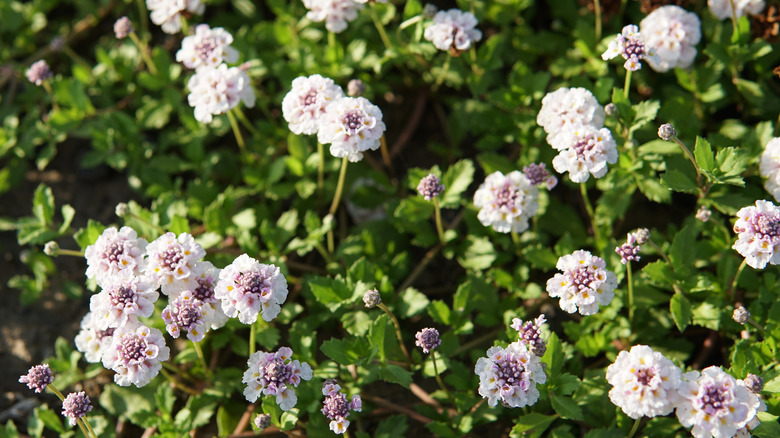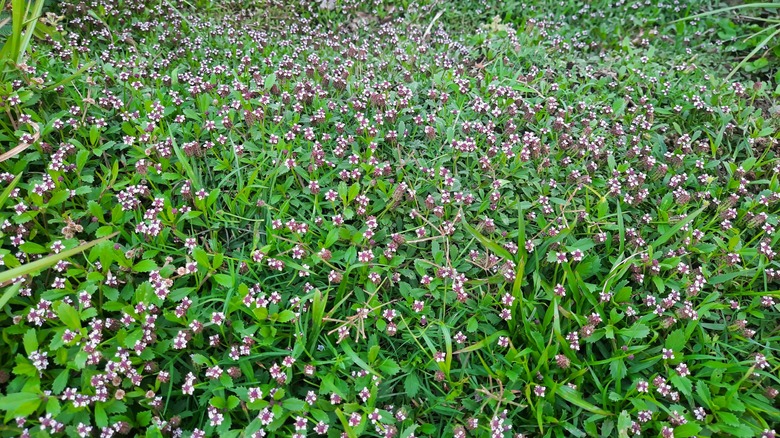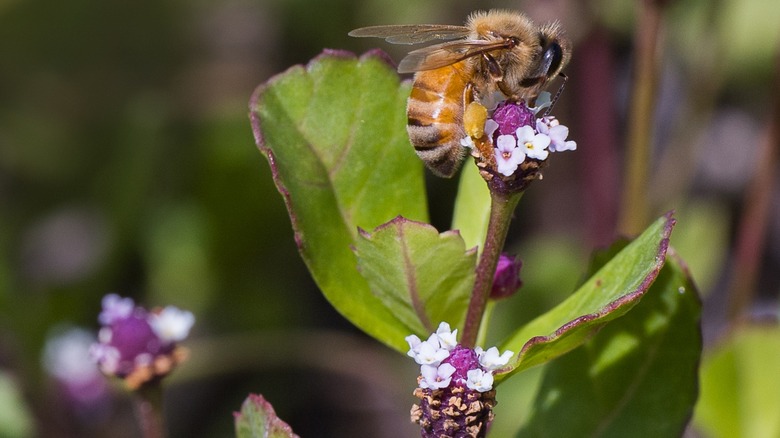Frogfruit: The Flowering Ground Cover That's Beneficial To Pollinators & Your Lawn
The classic lawn, with its uniform green blades, is a sight many strive for, but it requires a pretty demanding maintenance schedule. What if you could ditch it for or repair damaged patches with a ground cover that gifts your yard with showy flowers and becomes a buzzing hub for pollinators, all while asking little from your busy schedule? Enter frogfruit. This groundcover plant doesn't just settle comfortably in diverse environments — it flourishes, creating a living carpet that invites a parade of butterflies and bees to your backyard. This stunning grass alternative is also resilient to drought, sustaining its lush green color all year long without constant babysitting.
This hardy perennial is known among scientific scholars as Phyla nodiflora, with its other aliases being Texas frogfruit and Turkey tangle frogfruit. Happiest in USDA hardiness zones 6 through 11, frogfruit isn't as picky about its growing spot as other plants, doing well in a variety of soil types and conditions, inclusive even of those with poor drainage and high salinity. Its foliage, which sometimes assumes reddish or purplish hues in the winter, stretches out into a dense, 6-inch high mat that can sprawl up to 4 feet wide. But the true spectacle unfolds from May to October when frogfruit puts on a show with clusters of gorgeous white-pinkish flowers that add a splash of color and biodiversity to your yard. And, if you're up for some more drama, nestle it in a hanging basket and watch frogfruit's trailing foliage become a living piece of art.
Frogfruit's many benefits for your lawn
If you're wondering why you should consider frogfruit for your lawn, its many virtues speak for themselves. For one, it can blend in with what you've already got in your lawn or step up as a grass replacement. Now, imagine a ground cover plant that enhances your lawn's aesthetics with vibrant flowers and lush carpet-like foliage. You could even incorporate stepping stones or pavers amidst the ground cover to break up the green expanse with charming bits of stone.
Frogfruit is built to last. Whether it's in soggy soil or a parched patch in your expansive lawn, it adapts and thrives. The dense mat formed by this ground cover is like nature's own weed suppressor, all while keeping soil in sloped areas of your garden intact. It's a ground cover that works smarter, not harder. However, it's got its preferences; mainly, it's not into heavy foot traffic. In addition, the saplings will appreciate dedicated watering until they take root firmly.
The beauty of nurturing this stunning lawn alternative or companion lies in its straightforward upkeep once the transplants find their footing. Watering becomes an occasional affair, usually just during prolonged dry spells. And as for fertilizing? It drifts into the background as an optional boost for flower production rather than an absolute necessity. Not to mention the conventional chore of mowing becomes an optional aesthetic choice rather than a periodic must-do. If you prefer a neater look, a gentle trim after flowering might just do the trick.fin
How does frogfruit benefit pollinators?
Got a soft spot for the buzzing and flitting of local wildlife in your yard? Frogfruit is a must-have. It brings forth tiny, white to pinkish flowers on a dark purple cone perched on skinny stalks. These blossoms, serving as a nectar hotspot, bring more pollinators into your yard, including bees and butterflies (think hairstreaks, Cassius blue, common buckeye, white peacock, and Phaon crescent). Moreover, nurturing this impactful refuge for insects helps in the pollination of fruit-bearing plants like tomatoes. The flowers are also a big hit with predatory insects like wasps which feast on lawn pests such as clinch bugs.
Spring or early summer is your golden window to get frogruit groundcover in the ground. Kick things off with seeds in a bed of fertile soil, then transplant the seedlings into your lawn, spacing them out to about 3 feet apart. They'll soon stretch out and knit together into a green mat. While the plant can thrive in both full sun and part shade, a brighter area will maximize its flowering potential — and more blossoms mean more beneficial insects. A sprinkle of water here and there is all it takes for the transplants to take root in your lawn.
Word of caution: The quick-growing frogfruit is quite the ground taker. Its horizontal running stems sprawl far and wide, potentially over 20 feet, with plant-nurturing nodes sprouting every few inches. Fortunately, edging will suffice to keep this ground cover right where you want it.


